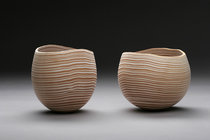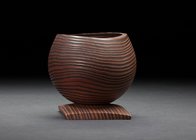is Douglas fir good for turning?
-
December 2025 Turning Challenge: Single Tree! (click here for details) -
Congratulations to Bob Henrickson, People's Choice in the November 2025 Turning Challenge (click here for details) -
Congratulations to Guillaume Fontaine for "Old Tea Pot" being selected as Turning of the Week for December 15, 2025 (click here for details) -
Welcome new registering member. Your username must be your real First and Last name (for example: John Doe). "Screen names" and "handles" are not allowed and your registration will be deleted if you don't use your real name. Also, do not use all caps nor all lower case.
You are using an out of date browser. It may not display this or other websites correctly.
You should upgrade or use an alternative browser.
You should upgrade or use an alternative browser.
douglas fir
- Thread starter Ed Jarvis
- Start date
Google the work of Bill Luce - he did some astounding work in Douglas Fir And actually enjoyed turning it. I live in the midst of a Doug Fir forest but have never had a piece on my lathe.
It's like many of the 'soft woods', hard to get clean cuts, smells nice, nice looking but not spectacular. If it's OLD Doug Fir, it can get harder, in a way, as the pitch gets hard, then it becomes quite brittle, with sizeable splinters.
In my experience hard to get a clean cut. Requires a lot more sanding.
Yes but you need to be up on your technique and sharpening
Doug Fir can be very beautiful. Like everyone else said, it can be challenging to work with. Clean cuts and minimal sanding is key. Like other softwoods, heavy sanding will result in unwanted texture, as the earlywood gets removed much more easily than the latewood. This is also why charring and sandblasting are so effective with timber like Doug Fir, Pines, etc…
That said, I think the potential is high for awe-inspiring pieces. Like Jeff mentioned, check out some of Bill Luce’s bowls. He was the master of Doug Fir. Here are a couple of examples:


That said, I think the potential is high for awe-inspiring pieces. Like Jeff mentioned, check out some of Bill Luce’s bowls. He was the master of Doug Fir. Here are a couple of examples:


Last edited:
It does work. I had a couple of 6 by 6s around after getting my shop and house built. I did drop one on the floor, and it broke a big chunk out of the rim. Not going to bother fixing it. I think that it would be a great texture wood if you took a wire brush or wheel to it after turning and maybe a light torching. The early and late wood rings can be nice for contrast. I would not consider it for long lived daily use bowls though.
robo hippy
robo hippy
Having turned thousands of balusters, newels, or porch posts from Douglas fir, Redwood or Western Red Cedar my simple answer is yes. Two things are needed to get a nicely finished product: A good SLICING technique and VERY SHARP tools. The result will be a product that is so smooth some painters will want you to give it a light sanding.
Ditto for what Terry Brown has written. I'm at the grinding wheel more often with Doug Fir and WR Cedar, but it's so beautiful it's worth it (for me).
It's possible there's a difference in outcome depending on where the Doug fir was grown or where the turner is working. The folks with good results are all in moister areas than I am, and I'm using arid mountain grown stock. YMMV
Get your hands on some reclaimed stuff, a joy to turn, and smells good to boot.
Get your hands on some reclaimed stuff, a joy to turn, and smells good to boot.
Back in the day my dad talked about doug fir as old growth or 2nd growth. Old growth being from huge trees in forests that had never been logged before, 2nd growth being the faster growing stuff in newer forests. The characteristics of the two aren't the same, it's not clear to me they are even the same wood. The old growth has very fine growth rings and nice wood to work with. 2nd growth has very coarse grain lines. not so nice wood to work with.
My guess is the pieces by Bill Luce shown in post #6 are 2nd growth because of the well defined growth rings.
Our 100+ year old house was built with old growth fir. You can still buy old growth, expensive though. A good source of turning size pieces are salvage beams from building tear downs. When Bill Gates was building his house his contractors bought all the salvaged beams on the market so they had a good selection of material to chose from.
